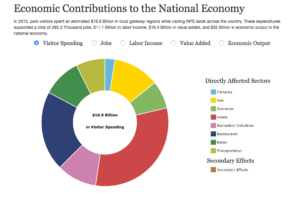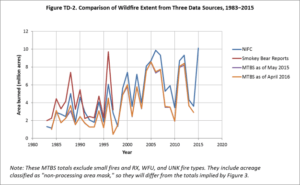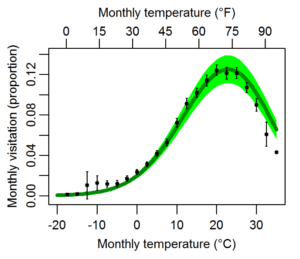Climate Change in America’s National Parks: To Preserve and Protect…Whatever’s Left

Will the organization tasked with protecting America’s natural resources have anything left to preserve?
Climate Change in National Parks
The National Park Service has two objectives, both of which are uniquely vulnerable to the effects of a warming planet: conservation and tourism.
NPS employs 22,000 workers overseeing 84M acres of public land across 50 states. It is a major player in the domestic tourism industry, serving over 300M visitors a year and managing a network of 600 “concessionaires” that provide hotel, food, and recreational services. [1, 2] Local communities are economically dependent on the parks: in 2015, park visitors spent nearly $17B, creating 295,000 jobs in these “gateway” regions. [3]
Climate change poses a threat to the Park Service in three distinct ways: the increasing destruction of ecosystems, unpredictable visitation to parks and park-adjacent communities, and the cost of updating park infrastructure.
Destruction of Ecosystems
From melting snowpack in Colorado to eroding shorelines in Alaska, unpredictable weather and seasonal patterns are threatening the very existence of the landscapes NPS seeks to protect. Scientists estimate that the largest of Montana’s Glacier National Parks’ eponymous glaciers will disappear by 2030; as sea-levels rise, the Everglades is seeing the retreat of freshwater species; the Forest Service’s “Smokey Bear Reports” show that longer, drier summers mean wildfires are more frequent, wide-spread, and longer lasting, sometimes resulting in park closures. [4, 5,6] Wildlife in the Parks face grave threats if they fail to adapt speedily. [6]
Unpredictable Park Visitation Patterns
Visitation to National Parks is strongly tied to air temperature, with visitation increasing up to about 80°F, then declining as temperatures rise. Based on projected future temperatures, many parks can expect a dramatic increase of 8-23% in visitation as additional warm weeks are added to the calendar, and those parks that are already warm will see a decrease in visitors and a shift in “tourist season.” The difficulty of predicting climate change’s effects year-to-year will create uncertainty for the many parks that open facilities only for specific time periods. [7,8]
Cost of Updating Park Infrastructure
NPS states that climate change threatens “$40B worth of national park assets and resources.” [9] Adapting the infrastructure that supports NPS’s preservation and tourism work—sewage systems, roads, trails, hotels and amenities, some dating from the 1930s—is a costly proposal, especially as the Service can engage in only limited long-term financial planning: it depends on yearly Congressional approval. The 2017 budget for NPS, at $2.5B, includes just $5.8M for climate-related activities—which itself represents a $3M increase from 2016—as well as $49M earmarked for deferred maintenance projects. [10]
NPS in Action
NPS is introducing bold new policies that encourage park managers to prepare for the unpredictable.
From Preservation to Activation
NPS has traditionally positioned its employees as stewards of America’s nature, more passive protectors than environmental warriors. Looking ahead, NPS is encouraging employees to actively study, create plans for, and invest in the park’s most vulnerable physical and natural assets. This plan includes a centralized effort to fund projects that demonstrate high climate-related vulnerability. [11, 12]
Designing for Sustainability and Unpredictability
Individual parks are increasingly mindful of reducing their own emissions: Pinnacles National Park’s new visitor center, for example, runs on solar electricity and was built using renewable power. [11]
Further, NPS is funding projects that anticipate extreme weather and can adapt accordingly: a new facility in the Everglades National Park was given an elevated design to avoid storm surges and sea-level rise. NPS is asking Park managers to consider designing movable structures, relocating highly-vulnerable assets, and integrating park services into regional infrastructure. [12]
Finally, NPS is partnering with adjacent land owners to create “landscape corridors” for flora and fauna that are seeking more suitable environments. [12]
Investing in Research
While NPS is encouraging its employees to engage in “scenario planning” to anticipate “critical uncertainties”, the agency is also investing in understanding these unknowns. In partnership with universities, NPS is investing in scientific research into the effects of climate change and potential solutions. The parks are an integral part of this effort due to their enormous size and biodiversity, home to projects ranging from the diagnosis of coral loss to the tracking of elk migrations. [9, 11, 12, 13, 14]
What’s Next?
There are additional steps NPS might consider in its future planning.
Firstly, NPS great physical footprint and popularity make it a potentially powerful educator for the general public about the changes ecosystems are experiencing. NPS should prioritize the vividly illustrating the real costs of climate change.
Secondly, NPS should translate this public education into a political movement. While NPS has many adaptation plans on paper, the Service requires budget to carry them out. That budget will only become available if voters pressure their legislators to make protecting America’s natural treasures a priority.
(Word Count: 785)
[1] National Park Service, “Frequently Asked Questions.” https://www.nps.gov/aboutus/faqs.htm
[2] National Park Service, “Doing Business With Us.” https://www.nps.gov/aboutus/doingbusinesswithus.htm
[3] National Park Service, “Visitor Spending Effects.” https://www.nps.gov/subjects/socialscience/vse.htm
[4] United States Geological Survey, “Retreat of Glaciers in Glacier National Park.” https://www.usgs.gov/centers/norock/science/retreat-glaciers-glacier-national-park?qt-science_center_objects=0#qt-science_center_objects
[5] National Park Service, “How Are the Saline Glades Changing?” https://www.nps.gov/ever/learn/nature/cceffectssalineglades.htm
[6] United States Department of Agriculture, “The Effects of Climate Change on Mammals.” http://www.fs.usda.gov/ccrc/topics/effects-climate-change-mammals
[7] National Park Service, “Park Visitation and Climate Change.” https://www.nps.gov/subjects/climatechange/visitation.htm
[8] Fisichelli NA, Schuurman GW, Monahan WB, Ziesler PS. “Protected Area Tourism in a Changing Climate: Will Visitation at US National Parks Warm Up or Overheat?” PLoS ONE 10 http://journals.plos.org/plosone/article?id=10.1371/journal.pone.0128226
[9] United States Department of the Interior, “In Paris, Secretary Jewell Releases Report on Actions Underway to Combat Climate Change in National Parks.” https://www.doi.gov/pressreleases/paris-secretary-jewell-releases-report-actions-underway-combat-climate-change-national
[10] National Park Service, “The United States Department of the Interior Budget Justifications and Performance Information Fiscal Year 2017” https://www.nps.gov/aboutus/upload/FY17-NPS-Greenbook-for-website.pdf
[11] The Atlantic, “How The National Park Service is Planning for Climate Change.” http://www.theatlantic.com/science/archive/2016/08/how-the-national-park-service-is-planning-for-climate-change/497042/
[12] National Park Service, “Adaptation.” https://www.nps.gov/subjects/climatechange/adaptation.htm
[13] United States Department of the Interior, “About the Climate Science Centers.” https://www.doi.gov/csc/about
[14] Discovery Magazine, “Why Are Yellowstone’s Elk Disappearing?” http://discovermagazine.com/2014/may/16-elk-vanishing-act






I completely agree that NPS should take on a more active role in educating the public about climate change. Taking it one step farther, it would be even more effective if the park could help visitors understand the changes they can make in their own lives to protect the climate. For example, NPS staff could use signage to tie educational information on the effect of climate change on parks to actions visitors can take, such as using energy-efficient products or conserving water. With an annual audience of 300M, NPS has a particularly strong platform for reaching diverse populations.
Hey Kiernan, great post! Disclaimer, I am bias – I grew up with annual family summer vacations at the parks so have a deep emotional connection to their preservation. Sophie’s comments above really resonate with me. NPS has a huge platform and can play a really powerful role in education for the next generation of Americans.
In my opinion, NPS as a travel brand has a major advantage over any other competitor in the family vacation business right now (Marriott, Disney, etc). “Responsible Tourism” is a big industry and growing, estimated at ~$25B globally. (http://www.responsibletravel.org/news/fact_sheets/fact_sheet_-_us_ecotourism.pdf) NPS by nature fits into this category, so by growing demand for its own product, it actually serves as a more eco-friendly substitute to other vacation choices. One demographic that NPS has not yet targeted is the luxury traveler. These are often the most wasteful travelers – staying in oversized accommodations, wasting linens, flying lots of miles (sometimes via private air travel). NPS should target this market and start generating demand at the high end for eco travel. Many of the high end hotel brands like Four Seasons and Ritz Carlton are becoming increasingly environmentally conscious (towel reuse programs, LEED certified buildings). However, if a percentage of those vacations could be fully converted to an NPS vacation, the impact would be much more significant.
To add on to Sophie’s comment re: the large annual audience, I would actually think it would be in everyone’s best interest if all of the national park organizations across the globe partnered together as one united front. Beyond the audience, these organizations are responsible for protecting and preserving a material amount of the world’s most valuable property — approximately 14% and 9% of total land in the US and Canada, respectively (1). Perhaps more importantly, I imagine these organizations may come under mounting pressure in decades ahead as the world searches for available arable land and natural resources. In that case, a more appropriate question to ask may be: as climate change evolves the face of our planet, under what circumstances do we expand/contract the land under protection?
(1) https://www.protectedplanet.net/country/US
Like Caroline, I also grew up traveling around the country to visit National Parks, including the Theodore Roosevelt National Park. However, I can’t help but see a certain irony in the fact that my family logged thousands of miles in our GHG emitting car to visit these national treasures. One area that NPS might consider investing a bit more time and money in is providing a virtual experience for those who are concerned about how their travel may contribute to environmental degradation and global warming. The cool part about virtual tours is that there are an increasing number of media for NPS to take advantage of, including 3D and VR. While NPS offers virtual tours for some of their most popular destinations, there’s still a lot to be desired in terms of content and functionality (take a look here: https://www.nps.gov/yell/learn/photosmultimedia/virtualtours.htm). Moreover, NPS could leverage this platform to educate the broader population who might not otherwise have the resources to visit all of the U.S. National Parks.
Great read! And I love all the comments in response to this excellent post. Indeed, in the near future national parks can and perhaps should become repositories of documented evidence of “how it used to be” vs. “what it is now”. The fact is, some coastal state parks will be under water while others will completely change their flora and fauna. While it is sad to admit, state and national parks need to step into the role of not only protecting what is left but also helping remind us what it used to be.